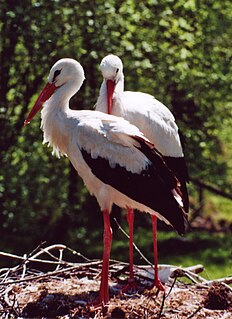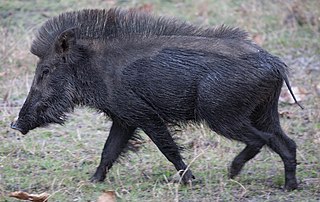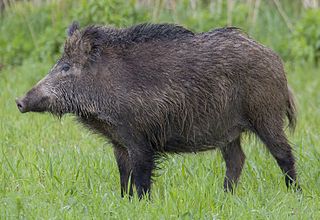
Sus is the genus of wild and domestic pigs, within the even-toed ungulate family Suidae. Sus include domestic pigs and their ancestor, the common Eurasian wild boar, along with other species. Sus species, like all suids, are native to the Eurasian and African continents, ranging from Europe to the Pacific islands. Suids other than the pig are the babirusa of Indonesia, the pygmy hog of South Asia, the warthogs of Africa, and other pig genera from Africa. The suids are a sister clade to peccaries.

The wild boar, also known as the wild swine, common wild pig, Eurasian wild pig, or simply wild pig, is a suid native to much of Eurasia and North Africa, and has been introduced to the Americas and Oceania. The species is now one of the widest-ranging mammals in the world, as well as the most widespread suiform. It has been assessed as least concern on the IUCN Red List due to its wide range, high numbers, and adaptability to a diversity of habitats. It has become an invasive species in part of its introduced range. Wild boars probably originated in Southeast Asia during the Early Pleistocene and outcompeted other suid species as they spread throughout the Old World.

The Barbary lion, also called the North African lion, Berber lion, Atlas lion, and Egyptian lion, is an extinct population of the lion subspecies Panthera leo leo. It lived in the mountains and deserts of the Barbary Coast of North Africa, from Morocco to Egypt. It was eradicated following the spread of firearms and bounties for shooting lions. A comprehensive review of hunting and sighting records revealed that small groups of lions may have survived in Algeria until the early 1960s, and in Morocco until the mid-1960s. Today, it is locally extinct in this region.
Tazekka National Park is a national park of Morocco. It was created in 1950 with an initial area of 6.8 km² to protect the natural resources around Jbel Tazekka, particularly the grove of cedars, which are isolated on this peak in the Middle Atlas range.
Swine most commonly refers to the domestic pig.

The Mediterranean dry woodlands and steppe is a Mediterranean forests, woodlands, and scrub ecoregion of North Africa. It occupies interior plateaus and mountain ranges of the Maghreb region, lying generally between the coastal Mediterranean woodlands and forests to the north and the Sahara to the south.

Boar–pig hybrid is a hybridized offspring of a cross between the Eurasian wild boar and any domestic pig. Feral hybrids exist throughout Eurasia, the Americas, Australia, and in other places where European settlers imported wild boars to use as game animals. In many areas, a variable mixture of these hybrids and feral pigs of all-domesticated original stock have become invasive species. Their status as pest animals has reached crisis proportions in Australia, parts of Brazil, and parts of the United States, and the animals are often freely hunted in hopes of eradicating them or at least reducing them to a controllable population.
A pig is a mammal of the genus Sus.

Ifrane National Park is a national park located in the Middle Atlas mountain range, in Morocco. Its territory extends over the Western part of the Middle Atlas mountains and areas within the provinces of Ifrane and Boulmane. It was established in 2004 and covers an area of 125,000 hectares. Much of the park is forested with Atlas cedar. Ifrane National Park is one of the few remaining habitats for the Barbary macaque, Macaca sylvanus; this primate prehistorically had a much broader range in North Africa, but currently survives as an endangered species in narrowly restricted and fragmented habitats.

The banded pig also known as the Indonesian wild boar is a subspecies of wild boar native to the Thai-Malay Peninsula and many Indonesian islands, including Sumatra, Java, and the Lesser Sundas as far east as Komodo. It is known as the wild boar in Singapore. It is the most basal subspecies, having the smallest relative brain size, more primitive dentition, and unspecialised cranial structure. It is a short-faced subspecies with a white band on the muzzle, as well as sparse body hair, no underwool, a fairly long mane, and a broad reddish band extending from the muzzle to the sides of the neck. It is much smaller than the mainland S. s. cristatus subspecies, with the largest specimens on Komodo weighing only 48 kg.

El Kouf National Park, established in 1975, is one of the seven national parks of Libya. El Kouf is located along Libya's northeastern Mediterranean coastline and has both marine and terrestrial biodiversity. Libya also has five other reserves, twenty four protected areas and two wetlands, Ain Elshakika Wetland and Ain Elzarga Wetland, protected under the Ramsar Convention since 2000.

The Indian boar, also known as the Andamanese pig or Moupin pig, is a subspecies of wild boar native to India, Nepal, Myanmar, western Thailand and Sri Lanka

The Japanese boar, also known as the white-moustached pig, nihon-inoshishi (ニホンイノシシ), or yama kujira, is a subspecies of wild boar native to all of Japan, save for Hokkaido and the Ryukyu Islands.

The Central European boar is a subspecies of wild boar, currently distributed across almost all of mainland Europe, with the exception of some northern areas in both Scandinavia and European Russia and the southernmost parts of Greece. It is a medium-sized, dark to rusty-brown haired subspecies with long and relatively narrow lacrimal bones. In Northern Italy, artificially introduced S. s. scrofa have extensively interbred with the smaller sized indigenous S. s. majori populations since the 1950s.

The Central Asian boar is a small long maned subspecies of wild boar indigenous to Southeastern Iran, Pakistan and Northwest India.

The Anatolian boar is a subspecies of wild boar endemic to Turkey, Levant, Israel and Transcaucasia. It is likely to be one of the ancestors of today's domestic pigs.

The Mediterranean High Atlas juniper steppe is a montane grasslands and shrublands ecoregion in Morocco. It extends along the High Atlas range of northwestern Africa's Atlas Mountains.













